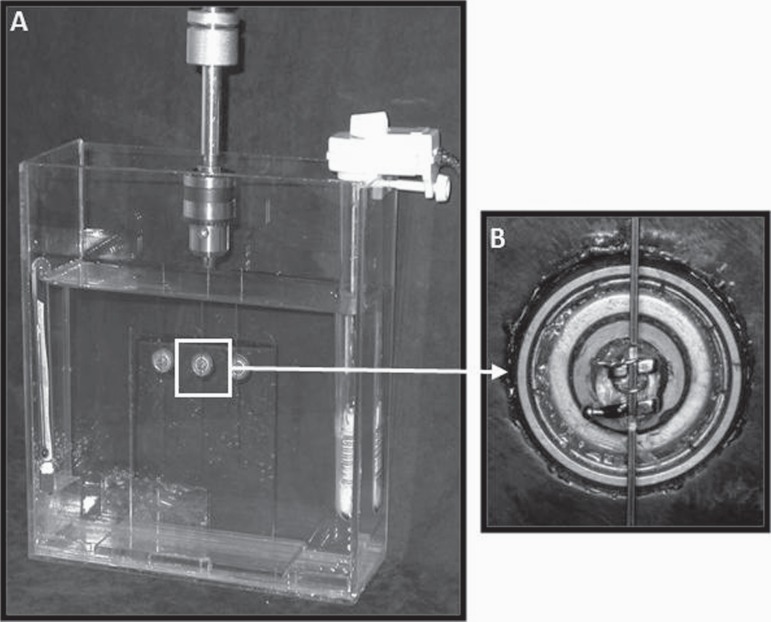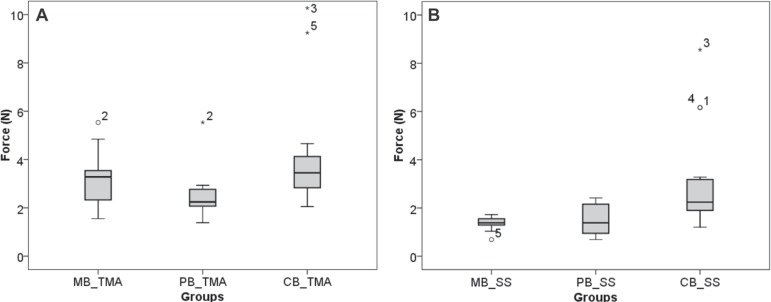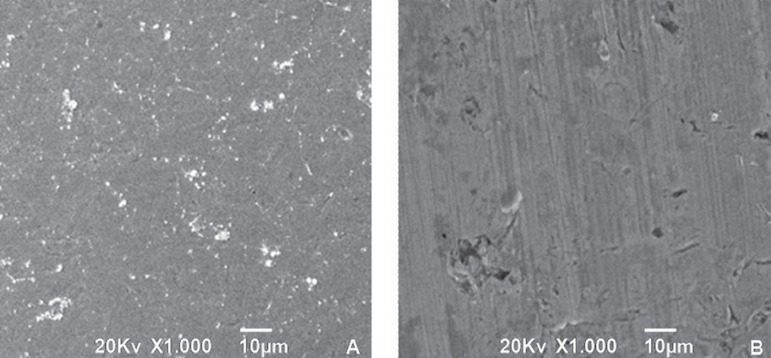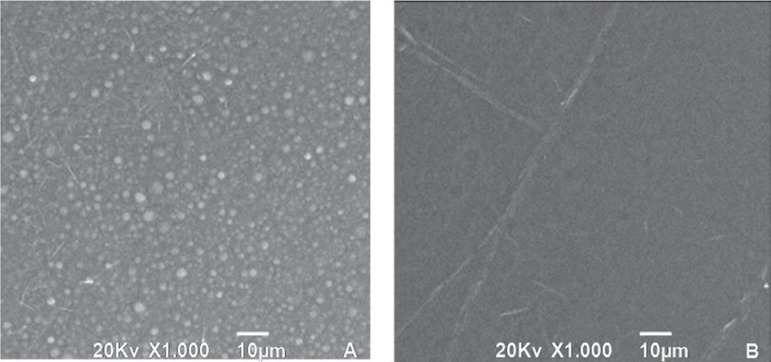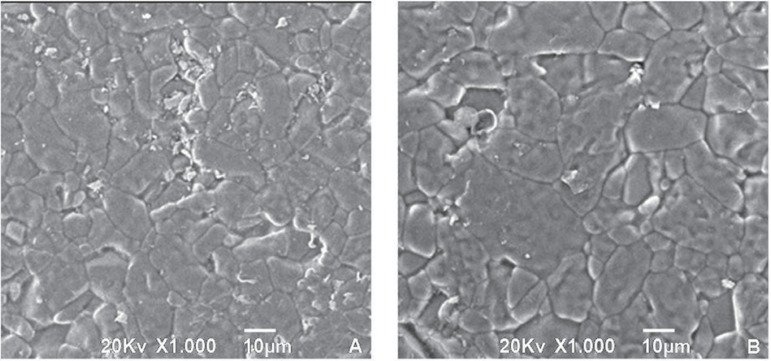Abstract
Objective
The objective this work was to assess the friction coefficient between brackets and wires of different materials under conditions simulating the oral environment.
Material and Methods
Stainless steel (SS) and titanium-molybdenum alloy (TMA) wires of 0.019x0.025-in diameter (American Orthodontics) and polycarbonate bracket (American Orthodontics), ceramic bracket (American Orthodontics), and metal bracket (3M Unitek) with slots of 0.022x0.030-in were used. The friction coefficient was assessed by means of mechanical traction with the system immersed in artificial saliva. The mean roughness of both wire surface and bracket slots was evaluated by using a surface profilometer.
Results
The system using TMA wire and polycarbonate bracket had the highest roughness (p<0.05). SS wire with ceramic bracket had the highest friction coefficient, whereas the use of metallic bracket yielded the lowest (p<0.05). However, it was observed a statistically significant difference in the system using TMA wire and ceramic bracket compared to that using TMA wire and polycarbonate bracket (p=0.038).
Conclusion
Ceramic brackets in association with SS wire should be judiciously used, since this system showed a high friction coefficient.
Keywords: Friction, Tensile strength, Orthodontic brackets, Orthodontic wires, Topography
INTRODUCTION
A successful orthodontic movement is directly related to the ability of orthodontic wires to slide through brackets slots and tubes, and it is well known that the sliding resistance between the bracket slot and archwire can drastically influence the tooth movement3,22. The sliding mechanism is important not only to close the space, but also in the initial phase of the treatment in which leveling and alignment of the teeth occur9.
In an attempt to fulfill an increasingly aesthetic demand, aesthetic accessories consisting of different materials have been developed, among which are the aesthetic ceramic and polycarbonate brackets11. Therefore, these accessories alleviate the aesthetic problem despite the limitations of their use, such as fracture of the brackets, abrasion of antagonist teeth and, mainly, the increased friction resulting from the mechanical sliding24,26. Friction is defined as the force opposing the movement of two objects in direct contact to each other, and its direction is tangent to a common interface between both surfaces. The intensity of this force is closely related to the surface characteristics and properties of the materials involved1,23. Therefore, knowing the influence of different materials on the sliding mechanism, the aim of this study was to assess the frictional force existing between conventional and aesthetic brackets in association with stainless steel (SS) and titanium-molybdenum alloy (TMA) wires by correlating the mean roughness values of wires and bracket slots.
MATERIAL AND METHODS
Materials
Conventional right upper canine brackets (B) made of pure polycarbonate (PB; American Orthodontics, Sheboygan, WI, USA), ceramic (CB; American Orthodontics, Sheboygan, WI, USA), and SS (SSB; 3M Unitek, Monrovia, CA, USA) with slots of 0.022x0.030-in were used for study. SS and TMA wires (American Orthodontics), both measuring 0.019x0.025-in, were evaluated (Figure 1).
Figure 1.
Systems assessed and their respective abbreviations
| Bracket/Wire | Stainless steel | TMA |
|---|---|---|
| Metallic | SSB-SS | MB-TMA |
| Ceramic | CB-SS | CB-TMA |
| Polycarbonate | PB-SS | PB-TMA |
Mechanical Traction Test
A device for mechanical test was developed in order to simulate the sliding movement of the wire through the bracket slots as seen during the orthodontic treatment. This device consisted of a glass box with a support centrally positioned. Holes were perforated in this glass support to fit high-rotation penholders (Dabi Atlante, Ribeirão Preto, SP, Brazil) into which the brackets were inserted (Figure 2A). The penholders were filled with self-curing composite (3M Unitek, São Paulo, SP, Brazil), thus creating a base for bonding the brackets. The brackets were then positioned and bonded to their respective penholders by using cyanoacrylate ester (Super Bonder; Loctite, São Paulo, SP, Brazil) (Figure 2B). This set was hold within the glass box through lateral rods made from glass lamina in order to keep the system stable enough during the traction test. The glass box was designed to keep the system immersed in artificial saliva, thus providing a better simulation of the oral cavity. Also, a heater with thermostat was added to this system so that the inner temperature was maintained at 37°C during the whole experiment.
Figure 2.
A) Device made for stabilizing the combinations of bracket and wire during mechanical test. B) Detail of the bracket moving through the wire and angulation close to 0°
A rectified 8-cm segment from both orthodontic wires was attached to the universal testing machine (eMIC DL 10.000; São José dos Pinhais, PR, Brazil), mounted onto the bonded bracket with no active torque and then tied to it with an elastic thread (3M Unitek, USA) by using a ligature elastic applicator (Morelli, Sorocaba, SP, Brazil).
The universal testing machine simulated the sliding movement of the bracket through the orthodontic wire during the retraction movement of the canines, which yielded a total dislocation of 8 mm that corresponds to the mean width of a premolar.
A personal computer connected to the equipment recorded graphic results showing values of maximum load (N) generated by a load cell. Such a test was repeated 5 times for each of the 3 combinations of bracket/wire of each group.
Surface Roughness
The wings of the brackets were removed with a steel diamond discs (22-mm diameter, 0.15-mm thickness, ref. 7016, KG Sorensen, São Paulo, SP, Brazil) at low speed on a handpiece (Dabi Atlante) for reading through a profilometer (Surf Test SJ, 201, Mitutoyo Co., Kawasaki, Honshu, Japan). Three milliliters of slots of the 3 types of brackets were analyzed, yielding three readings for each bracket. Similarly, 5-mm segments of each wire submitted to mechanical traction test were sectioned, and 3 mm of them were analyzed, also yielding three readings for each wire.
Scanning Electronic Microscopy (SEM)
The orthodontic brackets and wires were randomly selected, and sectioned for analysis of their surface with a JeOL scanning electron microscope (2000 FX, Tokyo, Japan). The samples were separately washed with isopropylic alcohol for 5 min. Next, the orthodontic bracket and wires were positioned on a double-faced adhesive tape whose sequence was carefully recorded. The samples were then placed in the sample chamber of the microscope for visualization of the surfaces of the bracket slots and wires.
Statistical Analysis
The data obtained were submitted to simple ANOVA with Tukey’s test for post-hoc multiple comparison tests between the systems. Confidence interval was set at 95% (p<0.05).
RESULTS
SS wire had a lower mean value of roughness value compared to TMA wire. On the other hand, the polycarbonate bracket had a greater roughness compared to the ceramic and metallic ones (Table 1). The results regarding roughness of brackets and wires after be submitted to mechanical traction test demonstrated a reduction in the roughness in all materials studied, with the metallic brackets having the most significant reduction (61.7%) and the polycarbonate brackets having the lowest (47.6%).
Table 1.
Mean values for roughness in Å. Reading regarding 3-mm segment of each sample
| Condition | Wire | Bracket | |||
|---|---|---|---|---|---|
| Stainless steel | TMA | Metallic | Polycarbonate | Ceramic | |
| New | 3300 | 4900 | 13300 | 28600 | 28400 |
| Used | 1580 | 780 | 5100 | 14975 | 11333 |
Comparing the maximum mean friction values for the bracket systems using SS wire (Table 2), no statistically significant differences were found between metallic (SSB-SS) and polycarbonate (PBSS) brackets. There were significant differences between the systems of ceramic (CB-SS) and metallic brackets using SS wire (SSB-SS) (p<0.001*) as well comparing the systems CB-SS and PB-SS (p=0.001).
Table 2.
Statistical data on friction coefficient of the systems of bracket and wire (n=15)
| System 1 | System 2 | Significance | ||
|---|---|---|---|---|
| Abreviation Friction (N)±SD | Abreviation Friction (N)±SD | p-value | ||
| SSB-SS | 1.37±0.26 | PB-SS | 1.48±0.62 | 0.999 |
| SSB-SS | 1.37±0.26 | CB-SS | 3.20±2.01 | <0.001* |
| PB-SS | 1.48±0.62 | CB-SS | 3.20±2.01 | 0.001* |
| SSB-TMA | 3.14±1.22 | PB-TMA | 2.54±0.95 | 0.698 |
| SSB-TMA | 3.14±1.22 | CB-TMA | 4.16±2.40 | 0.34 |
| PB-TMA | 2.54±0.95 | CB-TMA | 4.16±2.40 | 0.038* |
| SSB-SS | 1.37±0.26 | SSB-TMA | 3.14±1.22 | 0.012* |
| PB-SS | 1.48±0.62 | PB-TMA | 2.54±0.95 | 0.396 |
| CB-SS | 3.20±2.01 | CB-TMA | 4.16±2.40 | 0.518 |
Significance level of 95% (*p<0.05; ANOVA and Tukey's post hoc test). SD=Standard deviation
With regard to systems of brackets using TMA wire, no statistically significant differences were found between metallic (SSB-TMA) and polycarbonate (PB-TMA) brackets or between metallic (SSB-TMA) and ceramic (CB-TMA) brackets. However, statistically significant differences were observed between the PB-TMA and CB-TMA systems (p=0.038).
The SSB-SS system had the lowest friction coefficient, differing significantly from the SSB-TMA (p=0.012). However, when the systems PB-SS and CB-SS were compared to the systems PB-TMA and CB-TMA, respectively, no statistical differences were found.
The SSB-SS and CB-SS systems had the lowest and highest friction coefficients, respectively. Figure 3A shows that the friction coefficient tends to be even higher in the CB-SS group. On the other hand, the PB-TMA system had the lowest friction coefficient, followed by the SSB-SS and CB-TMA systems, with the highest friction coefficient among all systems (Figure 3B).
Figure 3.
Box plot showing maximum frictional coefficients between metal, polycarbonate, and ceramic brackets in association with different wires: A) Stainless steel wire; B) Titanium-molybdenum alloy (TMA) wire. Simple analysis of variance (ANOVA) and Tukey’s test as post hoc multiple comparison test at confidence interval of 95% (* p<0.05)
The TMA wire (Figure 5A, B) has less smooth surfaces compared to SS wire (Figure 4A, B). The conventional metallic bracket (Figure 6A, B) also exhibits a smoother surface than the polycarbonate (Figure 7A, B – polymers homogeneously distributed) and ceramic (Figure 8A, B – the most irregular surface among all) brackets.
Figure 5.
Scanning electron microscopy micrograph showing surface topography of SS wire (associated with MB) before (A) and after (B) mechanical traction
Figure 4.
Scanning electron microscopy micrograph showing surface topography of TMA wire (associated with MB) before (A) and after (B) mechanical traction
Figure 6.
Scanning electron microscopy micrograph showing surface topography of MB slot (associated with SS wire) before (A) and after (B) mechanical traction
Figure 7.
Scanning electron microscopy micrograph showing surface topography of PB slot (associated with SS wire) before (A) and after (B) mechanical traction
Figure 8.
Scanning electron microscopy micrograph showing surface topography of CB slot (associated with SS wire) before (A) and after (B) mechanical traction
After the mechanical traction test, the surfaces of all materials studied were more polished, which was more evident in the polycarbonate brackets and less evident in the ceramic brackets.
DISCUSSION
The friction on a given surface is closely related to both material involved and surface characteristics4,10,14,15. With regard to roughness, the SS wire exhibited less irregular surface compared to that of TMA wire, thus corroborating other findings in the literature16,18and confirming that the greater the roughness, the higher the friction coefficient22. In the present study, the systems using TMA wire had a higher friction coefficient regardless of the type of bracket used. In addition, TMA has been shown to present lower modulus of elasticity, springback greater than that of steel8. With regard to the brackets, the slots of metallic brackets exhibited less roughness compared to those of polycarbonate and ceramic ones. However, the polycarbonate bracket showed a friction coefficient lower than that of ceramic bracket either with SS wire (p=0.01) or TMA wire (p=0.038), both statistically significant. This may be explained by the fact that the profilometer could not detect small irregularities which were easily observed in the SeM images, and the ceramic bracket showed more irregularities than the polycarbonate accessory, thus justifying the similarity of roughness between SS and TMA wires.
The authors developed an apparatus that was immersed in artificial saliva during mechanical traction test, which not only reduces the friction but also simulates the sliding mechanism as seen in vivo and control an important variable, the lubrication21,28. Furthermore, studies demonstrated that lubrication reduces significantly the friction between bracket and wire14,23,27,28. Also, a device was developed to correct the small vertical angulations so that the angle formed between wire and bracket was close to 0°, thus helping to reduce the friction coefficient. According to the literature, friction coefficient increases as the angulation between bracket and wire increases20, 29.
Generally, when extraction is indicated during orthodontic treatment, closing of extraction spaces can be performed mainly by canine retraction through distal movement13. For this reason, canine brackets were selected for the present study. Wire was attached to the bracket with elastic ligatures because it promotes an additional force in comparison to wire ligature2,12. In addition, attachment to the bracket with elastic guarantees a standard force in comparison to the wire ligature.
The different combinations comparing the SSBSS and PB-SS systems showed that both yielded the lowest friction coefficients without statistically significant differences. This fact is explained by the use of brackets and wires made from the same material, which reduces friction as surfaces from the same material tend to have less friction compared to surfaces from different materials, in addition to their low roughness compared to other groups. With regard to the PB-SS system, despite using different materials, the low friction coefficient observed may be explained by the fact that the polymeric chains (macromolecules consisting of simple molecules) are small spheres homogeneously distributed on the surface of the polycarbonate bracket, being partially responsible for its roughness. These factors may explain the lack of statistically significant difference in the low friction coefficient between these both systems.
On the other hand, the CB-SS system had the highest friction coefficient, being statistically significant different from the SSB-SS system, which is also in agreement with the literature5,19,30. This can be explained by the higher surface roughness of the ceramic brackets and also by the different wire material (SS)26, thus making the sliding movement of the bracket through the wire difficult. In addition, the ceramic bracket showed higher friction coefficient compared to the polycarbonate bracket, since the former consists of crystal grains that are clearly larger than the monomers of the polycarbonate. As can be seen in the SeM images, the ceramic surface also exhibits more irregularities, thus increasing the friction.
Similarly, no statistically significant difference between polycarbonate and metallic brackets was found when they were used in combination with TMA wire, with both systems having a lower friction coefficient. Significant difference was observed in relation to the ceramic brackets (p=0.038), but not between metallic and ceramic brackets. This is due to the fact that both ceramic bracket and TMA wire have higher friction coefficients because they have a rougher topography compared to other systems. However, no statistically significant difference was observed between polycarbonate and metallic brackets regarding the friction coefficient because of the increased friction observed in relation to the SS wire.
The TMA wire allows flexibility and short-range movements16. However, even in the final phases of the treatment in which the long-range movements are not the main goal, TMA wire should be carefully used as the results of the present study have shown that its friction is significantly higher than that of SS wire for metallic brackets, a finding also corroborated elsewhere6,7. However, when polycarbonate and ceramic brackets are used in combination with TMA wire, the friction coefficient decreases compared to systems using SS wire. It is suggested that despite the brackets being of different materials and TMA wire having a rougher surface compared to SS wires, it is possible that the flexibility of the TMA wire might have produced less friction, reducing the frictional resistance for small inclination angles, although the brackets were in a rotating platform. Therefore, no statistically significant difference between metallic and polycarbonate brackets was observed, whereas significant difference was found between the polycarbonate and ceramic brackets. This latter system also showed higher friction coefficient compared to the other systems, but with no statistically significant difference.
One can observe that the SS wire has a lower friction coefficient when used with metallic bracket compared to the TMA wire, which is well described in the literature17,25. As the materials composing brackets and wires of each system are different, no significant differences between the systems using polycarbonate and ceramic brackets in association with SS and TMA wires were observed.
The orthodontic brackets and wire submitted to mechanical traction tests were then evaluated by using a profilometer in order to verify changes on the surface. The results showed a decrease in the roughness of all materials tested: SS wire (52.2%), TMA wire (84.1%), polycarbonate bracket (47.6%), ceramic bracket (60.1%), and metallic bracket (61.7%). These results were corroborated by SEM analysis.
Based on the data obtained the present study, it is important to emphasize that in sliding mechanics the effective force to be clinically applied to metallic brackets should be increased when using TMA wire instead of SS wire in order to maintain a satisfactory speed of the tooth movement. On the other hand, this increased force requires other issues to be evaluated. Some undesirable consequences such as loss of anchorage, tooth inclination, root absorption, and intense pain may occur, among other complications that may cause short- and long-term irreversible damages. Future studies are suggested to evaluate how human salivary components act on the friction between bracket and wire during orthodontic treatment.
CONCLUSIONS
The following conclusions can be drawn: the system formed by metallic bracket and SS wire exhibited less roughness and lower friction.
the use of ceramic brackets with TMA wire should be judiciously used as this system was found to have a higher friction coefficient.
ACKNOWLEDGMENTS
The authors thank FAPERJ for the financial support.
REFERENCES
- 1.Al-Khatib S, Berradja A, Celis JP, Willems G. In vitro friction of stainless steel arch wire-bracket combinations in air and different aqueous solutions. Orthod Craniofac Res. 2005;8:96–105. doi: 10.1111/j.1601-6343.2005.00321.x. [DOI] [PubMed] [Google Scholar]
- 2.Baccetti T, Franchi L, Camporesi M, Defraia E, Barbato E. Forces produced by different nonconventional bracket or ligature systems during alignment of apically displaced teeth. Angle Orthod. 2009;79:533–539. doi: 10.2319/050508-249.1. [DOI] [PubMed] [Google Scholar]
- 3.Bortoly TG, Guerrero AP, Rached RN, Tanaka O, Guariza-Filho O, Rosa EA. Sliding resistance with esthetic ligatures: an in-vitro study. Am J Orthod Dentofacial Orthop. 2008;133:340, e1-7. doi: 10.1016/j.ajodo.2007.08.015. [DOI] [PubMed] [Google Scholar]
- 4.Burrow SJ. Friction and resistance to sliding in orthodontics: a critical review. Am J Orthod Dentofacial Orthop. 2009;135:442–447. doi: 10.1016/j.ajodo.2008.09.023. [DOI] [PubMed] [Google Scholar]
- 5.Cacciafesta V, Sfondrini MF, Ricciardi A, Scribante A, Klersy C, Auricchio F. Evaluation of friction of stainless steel and esthetic self-ligating brackets in various bracket-archwire combinations. Am J Orthod Dentofacial Orthop. 2003;124:395–402. doi: 10.1016/s0889-5406(03)00504-3. [DOI] [PubMed] [Google Scholar]
- 6.Cacciafesta V, Sfondrini MF, Scribante A, Klersy C, Auricchio F. Evaluation of friction of conventional and metal-insert ceramic brackets in various bracket-archwire combinations. Am J Orthod Dentofacial Orthop. 2003;124:403–409. doi: 10.1016/s0889-5406(03)00501-8. [DOI] [PubMed] [Google Scholar]
- 7.Cash A, Curtis R, Garrigia-Majo D, McDonald F. A comparative study of the static and kinetic frictional resistance of titanium molybdenum alloy archwires in stainless steel brackets. Eur J Orthod. 2004;26:105–111. doi: 10.1093/ejo/26.1.105. [DOI] [PubMed] [Google Scholar]
- 8.Claro CA, Abrão J, Reis SA. Forces in stainless steel, TiMolium and TMA intrusion arches, with different bending magnitudes. Braz Oral Res. 2007;21:140–145. doi: 10.1590/s1806-83242007000200008. [DOI] [PubMed] [Google Scholar]
- 9.Damon DH. The Damon low-friction bracket: a biologically compatible straight-wire system. J Clin Orthod. 1998;32:670–680. [PubMed] [Google Scholar]
- 10.Downing A, McCabe J, Gordon P. A study of frictional forces between orthodontic brackets and archwires. Br J Orthod. 1994;21:349–357. doi: 10.1179/bjo.21.4.349. [DOI] [PubMed] [Google Scholar]
- 11.Eliades T. Orthodontic materials research and applications: part 2. Current status and projected future developments in materials and biocompatibility. Am J Orthod Dentofacial Orthop. 2007;131:253–262. doi: 10.1016/j.ajodo.2005.12.029. [DOI] [PubMed] [Google Scholar]
- 12.Gandini P, Orsi L, Bertoncini C, Massironi S, Franchi L. In vitro frictional forces generated by three different ligation methods. Angle Orthod. 2008;78:917–921. doi: 10.2319/090607-420.1. [DOI] [PubMed] [Google Scholar]
- 13.Janson G, Maria FR, Barros SE, Freitas MR, Henriques JF. Orthodontic treatment time in 2- and 4-premolar-extraction protocols. Am J Orthod Dentofacial Orthop. 2006;129:666–671. doi: 10.1016/j.ajodo.2005.12.026. [DOI] [PubMed] [Google Scholar]
- 14.Karamouzos A, Athanasiou AE, Papadopoulos MA. Clinical characteristics and properties of ceramic brackets: a comprehensive review. Am J Orthod Dentofacial Orthop. 1997;112:34–40. doi: 10.1016/s0889-5406(97)70271-3. [DOI] [PubMed] [Google Scholar]
- 15.Keith O, Jones SP, Davies EH. The influence of bracket material, ligation force and wear on frictional resistance of orthodontic brackets. Br J Orthod. 1993;20:109–115. doi: 10.1179/bjo.20.2.109. [DOI] [PubMed] [Google Scholar]
- 16.Krishnan V, Kumar KJ. Mechanical properties and surface characteristics of three archwire alloys. Angle Orthod. 2004;74:825–831. doi: 10.1043/0003-3219(2004)074<0825:MPASCO>2.0.CO;2. [DOI] [PubMed] [Google Scholar]
- 17.Kusy RP, Whitley JQ. Coefficients of friction for arch wires in stainless steel and polycrystalline alumina bracket slots. I. The dry state. Am J Orthod Dentofacial Orthop. 1990;98:300–312. doi: 10.1016/S0889-5406(05)81487-8. [DOI] [PubMed] [Google Scholar]
- 18.Kusy RP, Whitley JQ. Effects of surface roughness on the coefficients of friction in model orthodontic systems. J Biomech. 1990;23:913–925. doi: 10.1016/0021-9290(90)90356-8. [DOI] [PubMed] [Google Scholar]
- 19.Kusy RP, Whitley JQ. Frictional resistances of metal-lined ceramic brackets versus conventional stainless steel brackets and development of 3-D friction maps. Angle Orthod. 2001;71:364–374. doi: 10.1043/0003-3219(2001)071<0364:FROMLC>2.0.CO;2. [DOI] [PubMed] [Google Scholar]
- 20.Kusy RP, Whitley JQ. Influence of archwire and bracket dimensions on sliding mechanics: derivations and determinations of the critical contact angles for binding. Eur J Orthod. 1999;21:199–208. doi: 10.1093/ejo/21.2.199. [DOI] [PubMed] [Google Scholar]
- 21.Kusy RP, Whitley JQ. Resistance to sliding of orthodontic appliances in the dry and wet states: influence of archwire alloy, interbracket distance, and bracket engagement. J Biomed Mater Res. 2000;52:797–811. doi: 10.1002/1097-4636(20001215)52:4<797::aid-jbm25>3.0.co;2-9. [DOI] [PubMed] [Google Scholar]
- 22.Nishio C, Motta AF, Elias CN, Mucha JN. In vitro evaluation of frictional forces between archwires and ceramic brackets. Am J Orthod Dentofacial Orthop. 2004;125:56–64. doi: 10.1016/j.ajodo.2003.01.005. [DOI] [PubMed] [Google Scholar]
- 23.Park JH, Lee YK, Lim BS, Kim CW. Frictional forces between lingual brackets and archwires measured by a friction tester. Angle Orthod. 2004;74:816–824. doi: 10.1043/0003-3219(2004)074<0816:FFBLBA>2.0.CO;2. [DOI] [PubMed] [Google Scholar]
- 24.Pithon MM, Oliveira MV, Ruellas AC, Bolognese AM, Romano FL. Shear bond strength of orthodontic brackets to enamel under different surface treatment conditions. J Appl Oral Sci. 2007;15:127–130. doi: 10.1590/S1678-77572007000200010. [DOI] [PMC free article] [PubMed] [Google Scholar]
- 25.Pratten DH, Popli K, Germane N, Gunsolley JC. Frictional resistance of ceramic and stainless steel orthodontic brackets. Am J Orthod Dentofacial Orthop. 1990;98:398–403. doi: 10.1016/S0889-5406(05)81647-6. [DOI] [PubMed] [Google Scholar]
- 26.Reicheneder CA, Baumert U, Gedrange T, Proff P, Faltermeier A, Muessig D. Frictional properties of aesthetic brackets. Eur J Orthod. 2007;29:359–365. doi: 10.1093/ejo/cjm033. [DOI] [PubMed] [Google Scholar]
- 27.Tanne K, Matsubara S, Hotei Y, Sakuda M, Yoshida M. Frictional forces and surface topography of a new ceramic bracket. Am J Orthod Dentofacial Orthop. 1994;106:273–278. doi: 10.1016/S0889-5406(94)70047-8. [DOI] [PubMed] [Google Scholar]
- 28.Thorstenson GA, Kusy RP. Effects of ligation type and method on the resistance to sliding of novel orthodontic brackets with second-order angulation in the dry and wet states. Angle Orthod. 2003;73:418–430. doi: 10.1043/0003-3219(2003)073<0418:EOLTAM>2.0.CO;2. [DOI] [PubMed] [Google Scholar]
- 29.Tselepis M, Brockhurst P, West VC. The dynamic frictional resistance between orthodontic brackets and arch wires. Am J Orthod Dentofacial Orthop. 1994;106:131–138. doi: 10.1016/s0889-5406(94)70030-3. [DOI] [PubMed] [Google Scholar]
- 30.Voudouris JC, Schismenos C, Lackovic K, Kuftinec MM. Self-ligation esthetic brackets with low frictional resistance. Angle Orthod. 2010;80:188–194. doi: 10.2319/110608-565.1. [DOI] [PMC free article] [PubMed] [Google Scholar]



